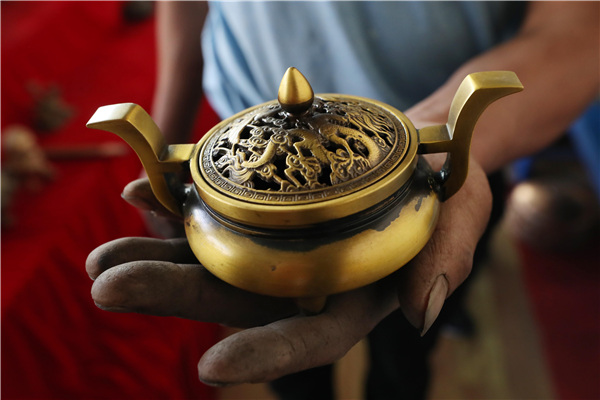Old bronze craft in Gansu fetches more money

Xu Xi is engrossed in each stroke of the imprinting knife when carving a mold. The 33-year-old artisan knows that the bronze pot it produces may one day become a symbol of wealth for a Tibetan family.
Without written instructions or a sketch, Xu engraves the eight auspicious patterns of Tibetan culture all by memory, adding another tint of mystery to the bronze ware craftsmanship that has been passed down orally from father to son for five centuries.
Using recyclable sand to make single-use molds, the technique of making bronze ware is an intangible cultural heritage in Qingshui, an ethnic Han village in the impoverished county of Minxian, Gansu province.
Most clients are Tibetans in Gansu, Qinghai and Sichuan provinces, and the Tibet autonomous region, whose fondness for copper utensils and ornaments and rising purchasing power have helped many Qingshui villagers shake off poverty.
"All my bronze pots have sold out, and the orders kept me busy throughout the year," says Xu, who earns between 100,000 yuan ($14,640) and 200,000 yuan a year.
In a local cooperative dedicated to bronze products, a variety of works are on display.
Xu Fanglong, a founder of the cooperative, recalls the days when they sold their products to itinerant traders, who then traveled to Tibetan regions to barter with herdsmen for rare herbs and cattle.
"Nowadays many Tibetan families drive cars to our village to directly buy from us," he says.
The market boom has helped keep the complicated craft afloat. The production involves over a dozen manual procedures and culminates with the smashing of the molds to retrieve finished products.
In recent years, the local government also revved up efforts to preserve the ancient technique while integrating it into the local poverty-reduction drive.
The prospering trade helped slash the village's poverty rate from about 26 percent in 2013 to 3.8 percent by the end of 2019, says Yang Fengming, a local official.
Xu Fanglong is proud of his new job offering guidance to those working at the cooperative.
"Most importantly, many young people are willing to stay in the village and train in the craft," he says.
